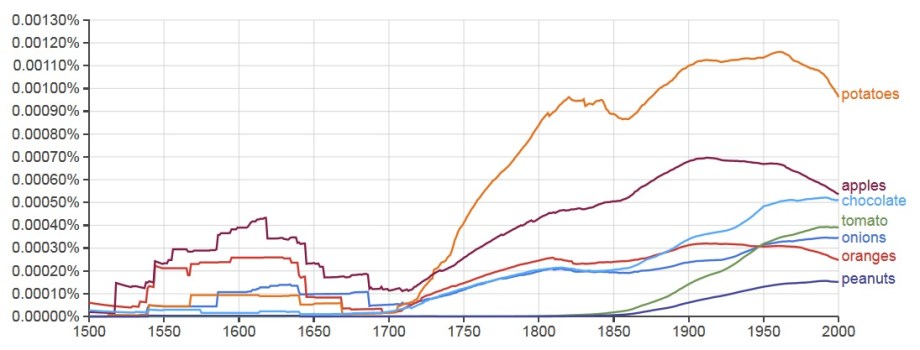One of the things that changed when the Old World of Europe and Asia met the New World of the Americas was what the people ate. Peppers, corn (though the English used the word for something else before importing our corn to their country), potatoes, tomatoes, chocolate, peanuts, pineapple, cranberries, sweet potatoes, vanilla, and zucchini were all New World foods. Old World foods included apples, cucumbers, onions, oranges and other citrus fruits, rice, wheat, sugar cane, lettuce, almonds, cinnamon, carrots, and grapes.
Here we share a few of our favorite lesson plans and classroom activities for grasping this important concept.
Sorting
For the youngest students, prepare a table with a map of the Americas at one end and a map of Europe on the other. If you have projects on the Pilgrims and Native Americans or on explorers, group the projects at either end of the table.
Bring foods or pictures of foods representing both the New and Old Worlds and have students sort them into stacks on the New World and Old World maps. If you use pictures, you can create either an interactive bulletin board or a center once you’ve presented the lesson. Of course, if you bring foods, you’re ready for snack time!
Mapping
Ask students to think about where tomato sauce might have come from. If they think of Italy, they’re right — except that while the tomato sauce we’re most familiar with was an Italian invention of the 1700s, tomatoes are a New World food. Pizza, which is an Italian invention from the late 18th century, could never have existed without the tomatoes of South America.
Have students choose some favorite foods and use the Food Timeline to identify when and where they originated. Then use one of these options to map the foods, making sure to distinguish between Old World and New World foods:
- Add pictures of the foods to the classroom wall map.
- Use Google Maps to create individual or group maps showing where specific foods originated.
- Have student create reports on their foods, post them on a bulletin board, and use yarn and pushpins to link the reports to their locations on a world map.
Ngram Viewer
The Ngram Viewer is a wonderful tool at Google Books which searches out the frequency of words at time depths from 1500 to 2008. In the screenshot at the top of this post you can see how Old World foods were most popular in books in English at the beginning of this time, how New World foods began to be mentioned in the 1500s, and how they gradually increased in popularity.
The Ngram Viewer is very easy to use. Have students type a term into the search box. By default, the viewer is case sensitive, but you can deselect that as shown above. We can see in this screen that chocolate was being written about shortly after it was taken to Europe by explorers, but that it became much more popular after English speakers began to live in the Americas, with a big jump during the 20th century. Try the same search within the corpus of Spanish (that is, the books in Spanish) and you will see a very different pattern.
The Ngram Viewer is a fun tool to use and it allows students to create charts in moments. Use it to practice the use of charts and to work on technology skills and visual learning.
Have students explore the use of the names of various Old and New World foods and look for patterns. Ask them to think about what they already know about the use of these foods and to conduct research on them. Then ask each student to choose one food to report on or two foods to compare.







